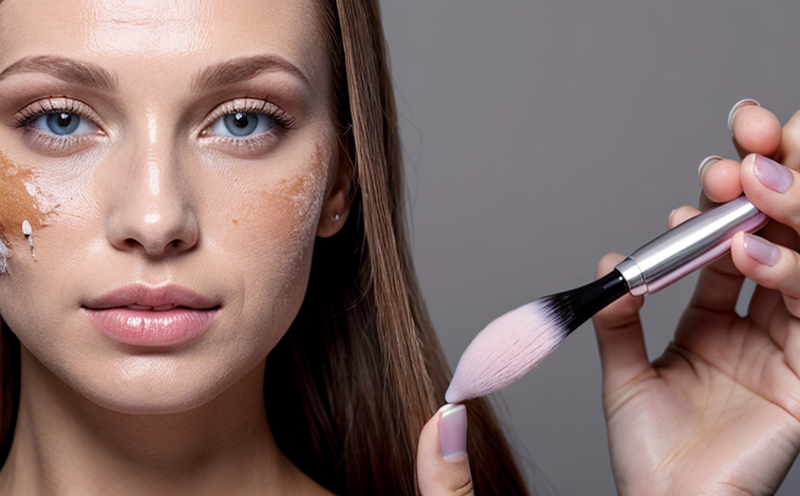AOAC Compliance Testing in Cosmetic Raw Materials
AOAC International (Association of Official Analytical Chemists) compliance testing is a critical component in ensuring that cosmetic raw materials meet the highest standards of safety, quality, and efficacy. This service ensures that the ingredients used in cosmetics are free from harmful substances such as pesticides, heavy metals, and other contaminants. For manufacturers and suppliers involved in the cosmetic industry, AOAC compliance provides assurance to regulatory bodies and customers that all materials conform to internationally recognized standards. The testing process involves a series of rigorous chemical analyses designed to detect trace amounts of harmful compounds. These tests are conducted using state-of-the-art instrumentation and methods specifically validated by AOAC International. Compliance testing is essential for several reasons:Firstly, it ensures that the raw materials used in cosmetic formulations comply with local and international regulations such as the EU Cosmetics Regulation (EC) No 1223/2009 and the FDA’s Good Manufacturing Practices (GMP). Adherence to these guidelines not only protects consumer health but also helps companies avoid costly legal issues.
Secondly, AOAC compliance testing aids in maintaining brand reputation by ensuring that products are safe for use. This is particularly important given the increasing scrutiny from regulatory authorities and the growing demand for transparency from consumers.
A third benefit of AOAC testing lies in its role as a quality assurance measure. By regularly submitting raw materials to these tests, companies can monitor changes in their supply chain or manufacturing processes that may affect material purity or safety. Early detection of potential issues allows for corrective actions to be taken promptly, minimizing risks.
The testing process itself involves multiple stages tailored specifically to the type and source of raw materials being evaluated. For instance, botanical extracts require different handling compared to synthetic chemicals due to their unique chemical profiles. Proper sampling methods are crucial; improper sampling could lead to misleading test results, thereby compromising product safety assessments.
During specimen preparation, samples undergo thorough cleaning procedures followed by precise weighing and dissolution in appropriate solvents if necessary. The chosen solvent must not interfere with the analyte of interest or alter its physical properties significantly during extraction. After dissolution, aliquots are prepared for various analytical techniques depending on what needs to be determined—such as pesticide residues, aflatoxins, or heavy metals.
For pesticides, AOAC Method 989.06 is commonly used which involves extracting the sample with methanol followed by analysis via gas chromatography-mass spectrometry (GC-MS). For aflatoxin detection, AOAC Method 2003.14 employs liquid chromatography-tandem mass spectrometry (LC-MS/MS) after extraction using acetonitrile-acidified water mixture.
Heavy metal analysis typically follows either AOAC Method 985.1 for lead or AOAC Method 2007.01 for mercury, both employing atomic absorption spectroscopy (AAS). These methods require careful calibration of instruments and strict adherence to procedural protocols to ensure accurate quantification.
The results obtained from these tests are then compared against specified limits set forth by relevant standards like those mentioned above. If any values exceed permissible levels, further investigation into the source or processing steps may be warranted until satisfactory compliance is achieved.
Benefits
Achieving AOAC compliance offers numerous advantages for cosmetic manufacturers and suppliers alike. Compliance enhances brand reputation by demonstrating a commitment to producing safe, high-quality products that meet industry best practices. It also helps companies navigate complex regulatory landscapes more effectively while reducing the risk of non-compliance penalties. Regulatory bodies rely heavily on AOAC standards when evaluating new products or ingredients entering the market. By ensuring their raw materials pass these stringent tests, businesses can expedite product launch timelines knowing they have met necessary criteria upfront. Moreover, AOAC certification fosters trust among consumers who increasingly seek out transparently produced goods aligned with global safety benchmarks. From an operational standpoint, regular AOAC testing supports continuous improvement initiatives within R&D departments by providing actionable insights into ingredient performance over time. This ongoing assessment encourages innovation while mitigating risks associated with unforeseen quality fluctuations during production processes.Eurolab Advantages
Eurolab, as one of the leading laboratories specializing in AOAC compliance testing for cosmetic raw materials, offers a comprehensive suite of services aimed at supporting clients throughout their journey towards meeting regulatory requirements. Our team comprises highly qualified scientists equipped with extensive experience and expertise across diverse sectors within the cosmetics industry.Our commitment to excellence extends beyond mere adherence to standards; we strive continuously to enhance our methodologies through cutting-edge research and development efforts. By staying abreast of emerging trends in analytical chemistry, Eurolab ensures that our testing protocols remain up-to-date with evolving best practices.
Eurolab’s advanced facilities provide the necessary infrastructure for conducting a wide range of AOAC tests, including but not limited to pesticide residue analysis, aflatoxin quantification, and heavy metal determination. Our state-of-the-art instrumentation ensures precise measurements capable of detecting even trace amounts of contaminants—a critical aspect when dealing with highly sensitive products.
We pride ourselves on delivering timely results while maintaining the highest level of accuracy and reliability. Clients can expect detailed reports complete with raw data, graphs, and interpretations tailored specifically to their needs. This transparency allows stakeholders across different levels—from R&D teams to quality control personnel—to understand exactly what went into each test result.
Another key advantage provided by Eurolab lies in our ability to offer customized solutions based on individual client requirements. Whether it’s developing new methods for specific raw materials or providing training sessions on proper sampling techniques, we are dedicated to supporting our partners every step of the way towards achieving AOAC compliance.
Lastly, our strong network of partnerships with other reputable organizations in the field enables us to stay informed about changes in regulations and guidance documents affecting the cosmetic industry globally. This proactive approach ensures that Eurolab remains at the forefront of developments impacting AOAC compliance testing, allowing us to provide timely updates and recommendations to our valued customers.





